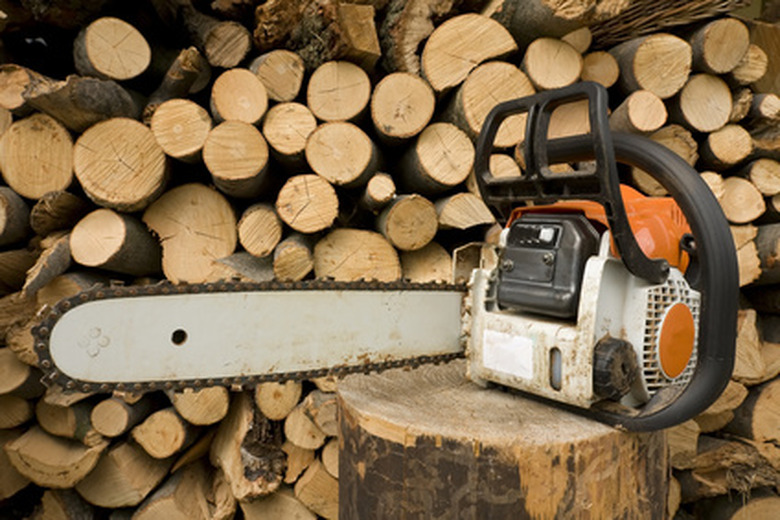Problem With Oil Leaking Onto Clutch Of Stihl MS250
The oil pump system on an MS250 chainsaw consists of a tank, pump and hoses. If you're leaking oil onto the clutch, then you probably have worn seals around the oil pump or ruptures in an old oil hose, according to the MS 250 service manual. In more extreme cases, the bore inside the pump may wear out. To access any leaking parts you must to remove the clutch and the oil pump.
Things Needed
- Wrench
- Screwdriver
- Rag
- Socket wrench
- Piston stop tool
- Metal hook
- Star wrench
- Needle-nosed pliers
- Oil pump installing tool
The oil pump system on an MS250 chainsaw consists of a tank, pump and hoses. If you're leaking oil onto the clutch, then you probably have worn seals around the oil pump or ruptures in an old oil hose, according to the MS 250 service manual. In more extreme cases, the bore inside the pump may wear out. To access any leaking parts you must to remove the clutch and the oil pump.
Step 1
Loosen the nuts holding the clutch cover in place, using the wrench. Loosen the bar tensioner screw with the screwdriver and release the chain's tension. Remove the bar nuts with your fingers. Pull off the bar cover, bar and chain. Wipe down the clutch housing area with the rag.
- The oil pump system on an MS250 chainsaw consists of a tank, pump and hoses.
- If you're leaking oil onto the clutch, then you probably have worn seals around the oil pump or ruptures in an old oil hose, according to the MS 250 service manual.
Step 2
Turn the saw upside down. Check the automatic oil screw, which will have a "+" and "-" next to it. Make sure it is set to just over half. Start the engine and let the saw idle for 30 seconds.
Step 3
Throttle the trigger and watch the automatic oiler nipple, which sits just in front of the bar posts, to see if oil seeps out. If the pump is working properly and you see oil coming out, clean the guide bar's oiler holes or replace the guide bar to solve your leaking problem. If no oil is present, you must remove the clutch and oil pump.
- Check the automatic oil screw, which will have a "+" and "-" next to it.
- If the pump is working properly and you see oil coming out, clean the guide bar's oiler holes or replace the guide bar to solve your leaking problem.
Step 4
Unscrew the spark plug with the socket wrench. Take it out of the engine. Place the piston stop tool into the spark plug hole. Pull on the starter rope until the piston hits the stop tool.
Step 5
Wedge the tip of the screwdriver underneath the E-clip on the crankshaft post. Pop the clip off. Remove the washer, rim sprocket and clutch drum from the crankshaft.
- Unscrew the spark plug with the socket wrench.
- Place the piston stop tool into the spark plug hole.
Step 6
Unscrew the bolt that holds the clutch in place with the socket wrench. Turn the bolt clockwise (left-hand thread) to remove it. Pull the three clutch springs with the metal hooks out of the clutch. Pull the clutch shoes and their retainers off with your hand.
Step 7
Remove the cover washer from the oil pump. Grab the worm drive, which looks like a bent spring, and pull it off the crankshaft. Take the drive spring off the worm gear. Replace the drive spring and worm gear if they are bent or heavily worn.
- Unscrew the bolt that holds the clutch in place with the socket wrench.
- Grab the worm drive, which looks like a bent spring, and pull it off the crankshaft.
Step 8
Unscrew the lower mounting screws on the front handle with the star wrench. Remove the handle from its groove. Pry out the three plugs inside the annular buffers with the screwdriver. These plugs sit in a triangle around the clutch. Unscrew the three screws sitting underneath the plugs. Pull the rear handle out of the engine. Pull off the front handle.
- Unscrew the lower mounting screws on the front handle with the star wrench.
- Pull the rear handle out of the engine.
Step 9
Remove the small screw, which sits above the oil suction hose and underneath the front handle, with the screwdriver. Pull the rubber connector out of the oil pump and suction hose using the needle-nosed pliers. Pull the suction hose and pickup body out of the oil tank with the needle-nosed pliers.
Step 10
Fit the oil pump installation tool to the bore on the annular buffer from the inside. Screw the fork head on the installation tool into the oil pump. Push the lever on the tool into the fork head. Fasten them together with the connecting pin. Pull the lever up to slide the oil pump out of its housing.
- Remove the small screw, which sits above the oil suction hose and underneath the front handle, with the screwdriver.
- Pull the rubber connector out of the oil pump and suction hose using the needle-nosed pliers.
Step 11
Disassemble and clean the oil pump. Check for any damage. Replace all of the seals on the pump housing. Inspect the piston bore for heavy wearing. Replace parts as necessary. Reassemble and reinstall these parts in reverse order.
Warning
Before making any of these repairs, drain and clean the oil tank. Leave any major repairs on the oil pump to an experienced mechanic if you are not qualified to repair it yourself.
